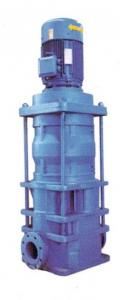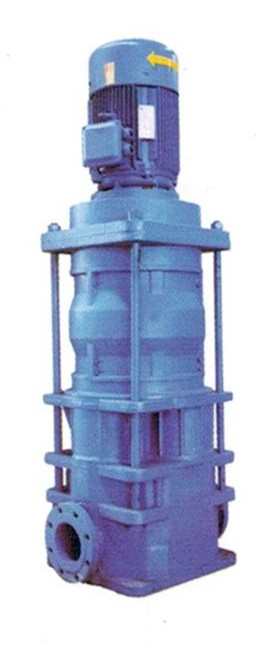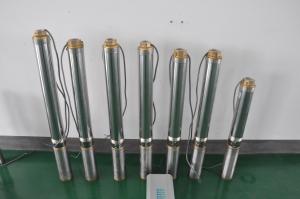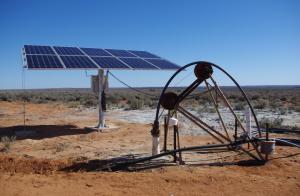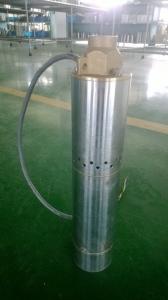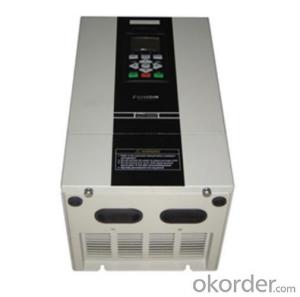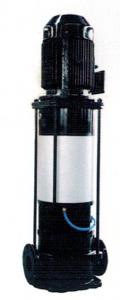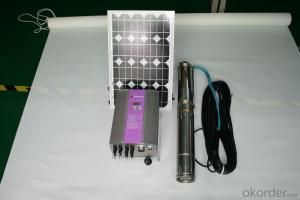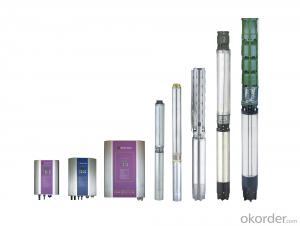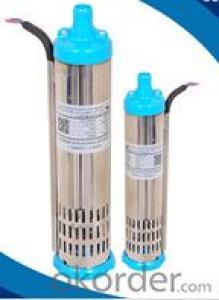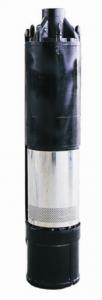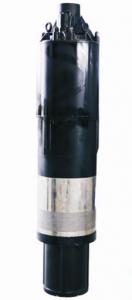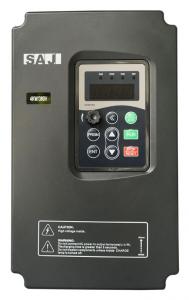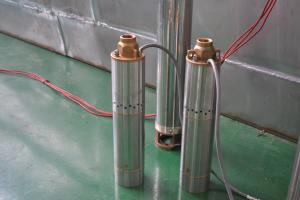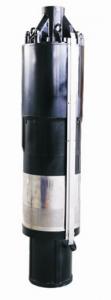Solar Pump for Irrigation L3D-90-80
- Loading Port:
- China Main Port
- Payment Terms:
- TT OR LC
- Min Order Qty:
- -
- Supply Capability:
- 300 sets /month
OKorder Service Pledge
OKorder Financial Service
You Might Also Like
Product description:
Product: Solar water pump
Model:L3D-90-80
Appilication:
surface pump
for surface water of pond, river, lake
for irrigation of a big farm with 50000 m2 on the top of a hill
Product specification:
flow rate:90m3/ hour, 630m3/day.
lift: 10m-80m
pump diameter: 610mm
Pump installed on the ground, outlet to the water surface:4m
with AC motor, motor power:22kW
but only need solar power:20kW(while Grundfos pump needs at least 45kW solar power, our pump can save more than 50% solar panel power,save USD15000 cost for solar panel per set.
Material:
Pump inside: stainless steel and wearable nylon,it enables our solar pump to have 10 years sevice life.
Motor : AC motor, 380V , three phase , 50Hz. The pump also can connect with grid power directly.
Certification:
3 International patent
ISO9001
CE
Warranty:2 years
- Q: Can a solar pump be used for water wells?
- Indeed, water wells can indeed benefit from the use of a solar pump. These pumps offer an effective and sustainable solution for extracting water from wells. By utilizing solar energy to power the pump, the reliance on electricity or fuel is completely eliminated. Consequently, solar pumps prove to be particularly useful in remote locations where grid power is inaccessible, making them an ideal choice for water wells situated in such areas. Not only are these pumps cost-effective and reliable, but they also require minimal maintenance. Furthermore, it is worth noting that solar pumps can be tailor-made to meet the specific water requirements of various well depths and flow rates, thereby ensuring efficient water extraction. All in all, solar pumps represent a viable and eco-friendly alternative for pumping water from wells.
- Q: Can a solar pump system be expanded or upgraded in the future?
- Yes, a solar pump system can be expanded or upgraded in the future. Solar pump systems are designed to be modular and scalable, allowing for easy expansion as per the user's needs. Additional solar panels can be added to increase the system's power output, allowing for more pumps or larger pumps to be operated. Similarly, the capacity of the battery bank can be increased to store excess power generated during the day for use during the night or during periods of low sunlight. Additionally, the control system and monitoring equipment can be upgraded to incorporate more advanced features, such as remote monitoring and automation. Overall, the flexibility and modularity of solar pump systems make them highly expandable and upgradeable, ensuring that they can adapt to changing requirements and technological advancements in the future.
- Q: Can a solar pump be used for water supply in refugee camps or emergency situations?
- Yes, a solar pump can definitely be used for water supply in refugee camps or emergency situations. Solar pumps are powered by sunlight, making them highly suitable for areas with limited access to electricity. They can efficiently extract water from wells, boreholes, or other water sources, providing a reliable and sustainable water supply for the displaced populations in refugee camps or emergency situations. Additionally, solar pumps are low-maintenance, environmentally friendly, and cost-effective, making them an ideal solution in such scenarios.
- Q: Are there any limitations to the temperature of the water a solar pump can handle?
- There are certain limitations to the temperature of water that a solar pump can handle. Most solar pumps have been designed to function within a specific temperature range, typically ranging from 32°F (0°C) to 104°F (40°C). This is because extreme temperatures outside of this range can impact the pump's effectiveness and efficiency. In the event that the water temperature drops below freezing, it can result in the water freezing inside the pump and pipes, which can lead to blockages and potential damage. Conversely, if the water temperature exceeds the upper limit, it can cause the pump to overheat, resulting in reduced efficiency and potential harm to its components. To address these potential risks, it is crucial to ensure that the solar pump system is appropriately sized and equipped with suitable insulation and protective mechanisms. Furthermore, regular maintenance and monitoring of the water temperature are advised to prevent any adverse effects on the pump's performance.
- Q: How does the size of the pumping mechanism affect the performance of a solar pump?
- The size of the pumping mechanism in a solar pump directly affects its performance. A larger pumping mechanism generally allows for greater water flow rate, enabling the pump to deliver water more efficiently. It also enables the pump to lift water from greater depths, increasing its overall effectiveness. Conversely, a smaller pumping mechanism may limit the water flow rate and the pump's capacity to lift water from deeper sources, resulting in reduced performance.
- Q: How does the type of solar panel (monocrystalline, polycrystalline, thin-film) affect the performance of a solar pump?
- The performance of a solar pump system can be significantly influenced by the type of solar panel used. Monocrystalline solar panels are renowned for their exceptional performance and high efficiency under direct sunlight. The uniform crystal structure of monocrystalline cells enables them to convert a greater percentage of sunlight into electricity, making them an ideal choice for regions with abundant solar radiation. Additionally, their efficiency allows for a smaller installation footprint, making them well-suited for areas with limited space. Consequently, a monocrystalline solar panel can greatly enhance the performance of a solar pump, maximizing its power output and efficiency. On the other hand, polycrystalline solar panels exhibit lower efficiency compared to monocrystalline panels. The cells in polycrystalline panels are composed of multiple silicon crystals, resulting in a less uniform structure. Despite their lower efficiency, polycrystalline panels can still generate a substantial amount of power and are more cost-effective than monocrystalline panels. In regions with moderate sunlight, polycrystalline panels can provide adequate energy for a solar pump system, albeit with a slightly reduced efficiency when compared to monocrystalline panels. Thin-film solar panels differ in their construction, as they involve depositing a thin layer of photovoltaic material onto a substrate. Although they possess the lowest efficiency among the three types, thin-film panels offer the advantages of flexibility and a lightweight design. They are also less affected by high temperatures and shade, making them suitable for installations with space constraints or irregular surfaces. However, due to their lower efficiency, a greater number of thin-film panels may be necessary to generate the same power output as monocrystalline or polycrystalline panels. Consequently, the performance of a solar pump system employing thin-film panels may be inferior to systems utilizing other panel types, particularly in areas with limited sunlight. To summarize, the performance of a solar pump system is heavily influenced by the type of solar panel utilized, whether monocrystalline, polycrystalline, or thin-film. Monocrystalline panels offer the highest efficiency and power output, making them ideal for regions with high solar radiation. Polycrystalline panels provide a cost-effective alternative that delivers reliable performance in moderate sunlight. Thin-film panels, despite their lower efficiency, offer flexibility and a lightweight design, catering to specific installation requirements. Ultimately, the selection of a solar panel type should be based on the unique conditions and requirements of the solar pump system.
- Q: What is the expected lifespan of the inverter in a solar pump system?
- The lifespan of an inverter in a solar pump system can vary based on several factors. On average, a well-maintained solar pump system with a high-quality inverter can endure for approximately 10 to 15 years. However, it's crucial to acknowledge that the inverter's lifespan can be influenced by various factors, including the brand and quality of the inverter, the overall system design, the environmental conditions in which the system operates, and the level of maintenance and care provided to the system. To significantly prolong the inverter's lifespan, it is advisable to employ a reputable and dependable brand of inverter, ensure proper installation, and perform regular maintenance routines. Moreover, the operating conditions, such as temperature and humidity, can also impact how long the inverter lasts. Conducting regular inspections, cleaning, and ensuring adequate ventilation around the inverter can help prevent overheating and extend its lifespan. Additionally, it is recommended to monitor the system for any indications of damage or malfunctions and promptly address them to avoid further complications. While a general expectation for the inverter's lifespan in a solar pump system is 10 to 15 years, it is crucial to consult the manufacturer's specifications and recommendations specific to the model and brand of the inverter in use.
- Q: Can a solar pump be used in areas with high humidity or precipitation?
- Solar pumps can be used in areas with high humidity or precipitation without any significant impact on their performance. As long as there is sufficient sunlight, the solar panels will generate electricity to power the pump, regardless of the weather conditions. In fact, areas with high humidity or precipitation can actually benefit solar pumps by keeping the solar panels clean, ensuring optimal energy production. Furthermore, solar pumps are specifically designed to withstand different weather conditions, including high humidity and precipitation. As a result, they can effectively be used for various applications in such areas, including irrigation, water supply, and wastewater management.
- Q: What is the warranty period for a solar pump system?
- The warranty period for a solar pump system can vary depending on the manufacturer and model, but it commonly ranges from 1 to 5 years.
- Q: Can solar pumps be used for water supply in religious institutions or temples?
- Yes, solar pumps can certainly be used for water supply in religious institutions or temples. Solar pumps are a sustainable and cost-effective solution that can provide a reliable water supply, especially in remote areas or regions with limited access to electricity. By harnessing energy from the sun, solar pumps can operate independently, reducing reliance on traditional power sources and minimizing operating costs. Consequently, religious institutions or temples can benefit from solar pumps by ensuring a consistent water supply for various purposes, such as drinking, sanitation, or ceremonial practices, while also promoting environmental consciousness.
Send your message to us
Solar Pump for Irrigation L3D-90-80
- Loading Port:
- China Main Port
- Payment Terms:
- TT OR LC
- Min Order Qty:
- -
- Supply Capability:
- 300 sets /month
OKorder Service Pledge
OKorder Financial Service
Similar products
Hot products
Hot Searches
Related keywords
